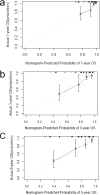Nomogram based on clinical characteristics and serological inflammation markers to predict overall survival of oral tongue squamous cell carcinoma patient after surgery
- PMID: 34961504
- PMCID: PMC8711158
- DOI: 10.1186/s12903-021-02028-7
Nomogram based on clinical characteristics and serological inflammation markers to predict overall survival of oral tongue squamous cell carcinoma patient after surgery
Abstract
Background: Oral tongue squamous cell carcinoma (OTSCC) is a prevalent malignant disease that is characterized by high rates of metastasis and postoperative recurrence. The aim of this study was to establish a nomogram to predict the outcome of OTSCC patients after surgery.
Methods: We retrospectively analyzed 169 OTSCC patients who underwent treatments in the Cancer Hospital of Shantou University Medical College from 2008 to 2019. The Cox regression analysis was performed to determine the independent prognostic factors associated with patient's overall survival (OS). A nomogram based on these prognostic factors was established and internally validated using a bootstrap resampling method.
Results: Multivariate Cox regression analysis revealed the independent prognostic factors for OS were TNM stage, age, lymphocyte-to-monocyte ratio and immunoglobulin G, all of which were identified to create the nomogram. The Akaike Information Criterion and Bayesian Information Criterion of the nomogram were lower than those of TNM stage (292.222 vs. 305.480; 298.444 vs. 307.036, respectively), indicating a better goodness-of-fit of the nomogram for predicting OS. The bootstrap-corrected of concordance index (C-index) of nomogram was 0.784 (95% CI 0.708-0.860), which was higher than that of TNM stage (0.685, 95% CI 0.603-0.767, P = 0.017). The results of time-dependent C-index for OS also showed that the nomogram had a better discriminative ability than that of TNM stage. The calibration curves of the nomogram showed good consistency between the probabilities and observed values. The decision curve analysis also revealed the potential clinical usefulness of the nomogram. Based on the cutoff value obtained from the nomogram, the proposed high-risk group had poorer OS than low-risk group (P < 0.0001).
Conclusions: The nomogram based on clinical characteristics and serological inflammation markers might be useful for outcome prediction of OTSCC patient.
Keywords: Inflammation markers; Oral tongue squamous cell carcinoma; Pretreatment nomogram; Prognosis; Surgery.
© 2021. The Author(s).
Conflict of interest statement
The authors declare that they have no competing interests.
Figures







Similar articles
-
Nutritional and immune-related indicators-based Nomogram for predicting overall survival of surgical oral tongue squamous cell carcinoma.Sci Rep. 2023 May 26;13(1):8525. doi: 10.1038/s41598-023-35244-y. Sci Rep. 2023. PMID: 37237026 Free PMC article.
-
[Establishment and verification of a prognostic nomogram for survival of tongue squamous cell carcinoma patients who underwent cervical dissection].Beijing Da Xue Xue Bao Yi Xue Ban. 2024 Feb 18;56(1):120-130. doi: 10.19723/j.issn.1671-167X.2024.01.019. Beijing Da Xue Xue Bao Yi Xue Ban. 2024. PMID: 38318906 Free PMC article. Chinese.
-
A Prognostic Model Based on Clinicopathological Features and Inflammation- and Nutrition-Related Indicators Predicts Overall Survival in Surgical Patients With Tongue Squamous Cell Carcinoma.Technol Cancer Res Treat. 2021 Jan-Dec;20:15330338211043048. doi: 10.1177/15330338211043048. Technol Cancer Res Treat. 2021. PMID: 34866500 Free PMC article.
-
A New Nomogram for Predicting Overall Survival and Assisting Postoperative Adjuvant Treatment Decision-Making in Stage II Oral Tongue Squamous Cell Carcinoma: A Surveillance, Epidemiology and End Results (SEER) Database Analysis.J Oral Maxillofac Surg. 2021 Oct;79(10):2147-2154. doi: 10.1016/j.joms.2021.04.010. Epub 2021 Apr 17. J Oral Maxillofac Surg. 2021. PMID: 34023287
-
The prognostic role of the pre-treatment neutrophil to lymphocyte ratio (NLR) and tumor depth of invasion (DOI) in early-stage squamous cell carcinomas of the oral tongue.Oral Maxillofac Surg. 2022 Mar;26(1):21-32. doi: 10.1007/s10006-021-00969-5. Epub 2021 Jun 9. Oral Maxillofac Surg. 2022. PMID: 34106358 Review.
Cited by
-
Identification of an individualized therapy prognostic signature for head and neck squamous cell carcinoma.BMC Genomics. 2023 Apr 28;24(1):221. doi: 10.1186/s12864-023-09325-1. BMC Genomics. 2023. PMID: 37106442 Free PMC article.
-
Pretreatment systemic immune-inflammation index and lymphocyte-to-monocyte ratio as prognostic factors in oral cavity cancer: A meta-analysis.Medicine (Baltimore). 2024 Nov 1;103(44):e40182. doi: 10.1097/MD.0000000000040182. Medicine (Baltimore). 2024. PMID: 39496022 Free PMC article.
-
Diagnostic Value of Inflammation-Related Indicators in Distinguishing Early Colon Cancer and Adenomatous Polyps.Cancer Control. 2023 Jan-Dec;30:10732748231180745. doi: 10.1177/10732748231180745. Cancer Control. 2023. PMID: 37421141 Free PMC article.
-
Novel pretreatment nomograms based on pan-immune-inflammation value for predicting clinical outcome in patients with head and neck squamous cell carcinoma.Front Oncol. 2024 Jun 10;14:1399047. doi: 10.3389/fonc.2024.1399047. eCollection 2024. Front Oncol. 2024. PMID: 38915366 Free PMC article.
-
Precision Medicine in Oral Health and Diseases: A Systematic Review.J Pers Med. 2023 Apr 25;13(5):725. doi: 10.3390/jpm13050725. J Pers Med. 2023. PMID: 37240895 Free PMC article. Review.
References
-
- Ng JH, Iyer NG, Tan MH, Edgren G. Changing epidemiology of oral squamous cell carcinoma of the tongue: a global study. Head Neck. 2017;39(2):297–304. - PubMed
-
- Riemann M, Knipfer C, Rohde M, Adler W, Schuster M, Noeth E, et al. Oral squamous cell carcinoma of the tongue: prospective and objective speech evaluation of patients undergoing surgical therapy. Head Neck. 2016;38(7):993–1001. - PubMed
-
- Brenner H. Long-term survival rates of cancer patients achieved by the end of the 20th century: a period analysis. Lancet. 2002;360(9340):1131–1135. - PubMed
-
- Shiboski CH, Schmidt BL, Jordan RC. Tongue and tonsil carcinoma: increasing trends in the U.S. population ages 20–44 years. Cancer. 2005;103(9):1843–1849. - PubMed
Publication types
MeSH terms
LinkOut - more resources
Full Text Sources
Medical

